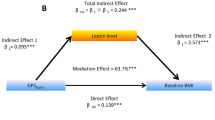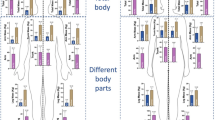Abstract
OBJECTIVE:
Shorter sleep duration predisposes to obesity, but the mechanisms whereby sleep deprivation affects body weight are poorly understood. We tested whether this association is modulated by the obesity genes FTO, TMEM18 and NRXN3.
SUBJECTS:
Body mass index (BMI), waist circumference, visceral fat (abdominal ultrasound), homeostasis model assessment for insulin resistance (HOMA-IR), systolic blood pressure (SBP) and sleep time per 24 h were assessed in 297 asymptomatic children (151 boys, 146 girls; age range 5–9 years; BMI s.d. score range −2.0–4.0). Associations between sleep duration and the abovementioned outcomes were tested for three common single-nucleotide polymorphisms (SNPs), namely FTO (rs9939609), TMEM 18 (rs4854344) and NRXN3 (rs10146997), as well as for their combination.
RESULTS:
TT homozygotes (but not A* carriers) for the FTO SNP, exhibited nominal associations between decreasing sleep duration and increasing BMI, waist circumference, visceral fat and HOMA-IR (all P<0.05). Similar associations were observed in children with risk alleles (but not in those without risk alleles) for the TMEM18 and NRXN3 SNPs (P<0.05 to P<0.0001). The three SNPs had additive effects on the negative associations between sleep and, respectively, BMI (P<0.001), waist (P<0.005), visceral fat (P<0.001), HOMA-IR (P=0.010) and SBP (P<0.0005). The combined effects on obesity measures and SBP remained significant after correction for multiple testing. On average, 2 h of sleep less per night was associated with an increase in BMI of 1.0 s.d. (95% confidence interval 0.5–1.6 s.d.) and with 8.0 cm (95% confidence interval 3.6–12.2 cm) more waist circumference in genetically susceptible children.
CONCLUSION:
By age 7, common variations in FTO, TMEM18 and NRXN3 influence the vulnerability to metabolic complications of sleep deprivation. Further genetic studies are warranted to replicate these findings in other populations.
This is a preview of subscription content, access via your institution
Access options
Subscribe to this journal
Receive 12 print issues and online access
$259.00 per year
only $21.58 per issue
Buy this article
- Purchase on Springer Link
- Instant access to full article PDF
Prices may be subject to local taxes which are calculated during checkout

Similar content being viewed by others
References
Patel SR, Hu FB . Short sleep duration and weight gain: a systematic review. Obesity (Silver Spring) 2008; 16: 643–653.
Cappuccio FP, Taggart FM, Kandala NB, Currie A, Peile E, Stranges S et al. Meta-analysis of short sleep duration and obesity in children and adults. Sleep 2008; 31: 619–626.
Nixon GM, Thompson JM, Han DY, Becroft DM, Clark PM, Robinson E et al. Short sleep duration in middle childhood: risk factors and consequences. Sleep 2008; 31: 71–78.
Van Cauter E, Blackman JD, Roland D, Spire JP, Refetoff S, Polonsky KS . Modulation of glucose regulation and insulin secretion by circadian rhythmicity and sleep. J Clin Invest 1991; 88: 934–942.
Brondel L, Romer MA, Nougues PM, Touyarou P, Davenne D . Acute partial sleep deprivation increases food intake in healthy men. Am J Clin Nutr 2010; 91: 1550–1559.
Meier-Ewert HK, Ridker PM, Rifai N, Regan MM, Price NJ, Dinges DF et al. Effect of sleep loss on C-reactive protein, an inflammatory marker of cardiovascular risk. J Am Coll Cardiol 2004; 43: 678–683.
Frayling TM, Timpson NJ, Weedon MN, Zeggini E, Freathy RM, Lindgren CM et al. A common variant in the FTO gene is associated with body mass index and predisposes to childhood and adult obesity. Science 2007; 316: 889–894.
Hotta K, Nakamura M, Nakamura T, Matsuo T, Nakata Y, Kamohara S et al. Association between obesity and polymorphisms in SEC16B, TMEM18, GNPDA2, BDNF, FAIM2 and MC4R in a Japanese population. J Hum Genet 2009; 54: 727–731.
Heard-Costa NL, Zillikens MC, Monda KL, Johansson A, Harris TB, Fu M et al. NRXN3 is a novel locus for waist circumference: a genome-wide association study from the CHARGE Consortium. PLoS Genet 2009; 5: e1000539.
Olszewski PK, Fredriksson R, Olszewska AM, Stephansson O, Alsio J, Radomska KJ et al. Hypothalamic FTO is associated with the regulation of energy intake not feeding reward. BMC Neurosci 2009; 10: 129.
Willer CJ, Speliotes EK, Loos RJ, Li S, Lindgren CM, Heid IM et al. Six new loci associated with body mass index highlight a neuronal influence on body weight regulation. Nature Genet 2009; 41: 25–34.
Gerken T, Girard CA, Tung YC, Webby CJ, Saudek V, Hewitson KS et al. The obesity-associated FTO gene encodes a 2-oxoglutarate-dependent nucleic acid demethylase. Science 2007; 318: 1469–1472.
Wardle J, Carnell S, Haworth CM, Farooqi IS, O’Rahilly S, Plomin R . Obesity associated genetic variation in FTO is associated with diminished satiety. J Clin Endocrinol Metabol 2008; 93: 3640–3643.
Cecil JE, Tavendale R, Watt P, Hetherington MM, Palmer CN . An obesity-associated FTO gene variant and increased energy intake in children. N Engl J Med 2008; 359: 2558–2566.
Berulava T, Horsthemke B . The obesity-associated SNPs in intron 1 of the FTO gene affect primary transcript levels. Eur J Hum Genet 2010; 18: 1054–1056.
Zhao J, Bradfield JP, Li M, Wang K, Zhang H, Kim CE et al. The role of obesity-associated loci identified in genome-wide association studies in the determination of pediatric BMI. Obesity (Silver Spring) 2009; 17: 2254–2257.
Takeuchi F, Yamamoto K, Katsuya T, Nabika T, Sugiyama T, Fujioka A et al. Association of genetic variants for susceptibility to obesity with type 2 diabetes in Japanese individuals. Diabetologia 2011; 54: 1350–1359.
Kelai S, Maussion G, Noble F, Boni C, Ramoz N, Moalic JM et al. Nrxn3 upregulation in the globus pallidus of mice developing cocaine addiction. Neuroreport 2008; 19: 751–755.
Rapaka R, Schnur P, Shurtleff D . Obesity and addiction: common neurological mechanisms and drug development. Physiol Behav 2008; 95: 2–9.
Haslam DW, James WP . Obesity. Lancet 2005; 366: 1197–1209.
Carrascosa Lezcano A, Fernandez Garcia JM, Fernandez Ramos C, Ferrandez Longas A, Lopez-Siguero JP, Sanchez Gonzalez E et al. Spanish cross-sectional growth study 2008. Part II. Height, weight and body mass index values from birth to adulthood]. An Pediatr (Barc) 2008; 68: 552–569.
Ferrozzi F, Zuccoli G, Tognini G, Castriota-Scanderbeg A, Bacchini E, Bernasconi S et al. An assessment of abdominal fatty tissue distribution in obese children. A comparison between echography and computed tomography]. La Radiologia medica 1999; 98: 490–494.
Serra-Majem L, Ribas L, Ngo J, Ortega RM, Garcia A, Perez-Rodrigo C et al. Food, youth and the Mediterranean diet in Spain. Development of KIDMED, Mediterranean Diet Quality Index in children and adolescents. Public Health Nutr 2004; 7: 931–935.
Byrne NM, Hills AP, Hunter GR, Weinsier RL, Schutz Y . Metabolic equivalent: one size does not fit all. J Appl Physiol 2005; 99: 1112–1119.
Ainsworth BE, Haskell WL, Leon AS, Jacobs Jr DR, Montoye HJ, Sallis JF et al. Compendium of physical activities: classification of energy costs of human physical activities. Med Sci Sports Exerc 1993; 25: 71–80.
Ainsworth BE, Haskell WL, Whitt MC, Irwin ML, Swartz AM, Strath SJ et al. Compendium of physical activities: an update of activity codes and MET intensities. Med Sci Sports Exerc 2000; 32 (9 Suppl): S498–S504.
Martinez-Gomez D, Martinez-De-Haro V, Del-Campo J, Zapatera B, Welk GJ, Villagra A et al. Validity of four questionnaires to assess physical activity in Spanish adolescents. Gac Sanit/SESPAS 2009; 23: 512–517.
Landhuis CE, Poulton R, Welch D, Hancox RJ . Childhood sleep time and long-term risk for obesity: a 32-year prospective birth cohort study. Pediatrics 2008; 122: 955–960.
Touchette E, Petit D, Tremblay RE, Boivin M, Falissard B, Genolini C et al. Associations between sleep duration patterns and overweight/obesity at age 6. Sleep 2008; 31: 1507–1514.
Taheri S . The link between short sleep duration and obesity: we should recommend more sleep to prevent obesity. Arch Dis Child 2006; 91: 881–884.
Rutters F, Gerver WJ, Nieuwenhuizen AG, Verhoef SP, Westerterp-Plantenga MS . Sleep duration and body-weight development during puberty in a Dutch children cohort. Int J Obes (Lond) 2010; 34: 1508–1514.
Andreasen CH, Stender-Petersen KL, Mogensen MS, Torekov SS, Wegner L, Andersen G et al. Low physical activity accentuates the effect of the FTO rs9939609 polymorphism on body fat accumulation. Diabetes 2008; 57: 95–101.
Rampersaud E, Mitchell BD, Pollin TI, Fu M, Shen H, O’Connell JR et al. Physical activity and the association of common FTO gene variants with body mass index and obesity. Arch Intern Med 2008; 168: 1791–1797.
Ruiz JR, Labayen I, Ortega FB, Legry V, Moreno LA, Dallongeville J et al. Attenuation of the effect of the FTO rs9939609 polymorphism on total and central body fat by physical activity in adolescents: the HELENA study. Arch Pediatr Adolesc Med 2010; 164: 328–333.
Sonestedt E, Gullberg B, Ericson U, Wirfalt E, Hedblad B, Orho-Melander M . Association between fat intake, physical activity and mortality depending on genetic variation in FTO. Int J Obes (Lond) 2011; 35: 1041–1049.
Fischer J, Koch L, Emmerling C, Vierkotten J, Peters T, Bruning JC et al. Inactivation of the Fto gene protects from obesity. Nature 2009; 458: 894–898.
Almen MS, Jacobsson JA, Shaik JH, Olszewski PK, Cedernaes J, Alsio J et al. The obesity gene, TMEM18, is of ancient origin, found in majority of neuronal cells in all major brain regions and associated with obesity in severely obese children. BMC Med Genet 2010; 11: 58.
Spiegel K, Tasali E, Penev P, Van Cauter E . Brief communication: sleep curtailment in healthy young men is associated with decreased leptin levels, elevated ghrelin levels, and increased hunger and appetite. Ann Intern Med 2004; 141: 846–850.
Taheri S, Lin L, Austin D, Young T, Mignot E . Short sleep duration is associated with reduced leptin, elevated ghrelin, and increased body mass index. PLoS Med 2004; 1: e62.
Kushida CA, Chang A, Gadkary C, Guilleminault C, Carrillo O, Dement WC . Comparison of actigraphic, polysomnographic, and subjective assessment of sleep parameters in sleep-disordered patients. Sleep Med 2001; 2: 389–396.
Sadeh A . A brief screening questionnaire for infant sleep problems: validation and findings for an Internet sample. Pediatrics 2004; 113: e570–e577.
Acknowledgements
We are grateful to all the children and parents who took part in this study. FdZ is a Senior Investigator of the Clinical Research Fund of the Leuven University Hospital, Belgium. LI is a Clinical Investigator of the CIBERDEM (Spanish Biomedical Research Centre in Diabetes and Associated Metabolic Disorders), from the National Institute of Health Carlos III, Spain. JB is an Investigator of the Sara Borrell Fund from the National Institute of Health Carlos III, Spain. AL-B is an Investigator of the I3 Fund for Scientific Research (Ministry of Science and Innovation, Spain). This work was supported, in part, by grant 10/00553 (to AL-B) from the National Institute of Health Carlos III (Fund for Health Research FIS, Spain).
Author information
Authors and Affiliations
Corresponding author
Ethics declarations
Competing interests
The authors declare no conflict of interest.
Rights and permissions
About this article
Cite this article
Prats-Puig, A., Grau-Cabrera, P., Riera-Pérez, E. et al. Variations in the obesity genes FTO, TMEM18 and NRXN3 influence the vulnerability of children to weight gain induced by short sleep duration. Int J Obes 37, 182–187 (2013). https://doi.org/10.1038/ijo.2012.27
Received:
Revised:
Accepted:
Published:
Issue Date:
DOI: https://doi.org/10.1038/ijo.2012.27
Keywords
This article is cited by
-
Childhood sleep duration modifies the polygenic risk for obesity in youth through leptin pathway: the Beijing Child and Adolescent Metabolic Syndrome cohort study
International Journal of Obesity (2019)
-
Inadequate sleep as a contributor to type 2 diabetes in children and adolescents
Nutrition & Diabetes (2017)
-
Sleep, Depressive/Anxiety Disorders, and Obesity in Puerto Rican Youth
Journal of Clinical Psychology in Medical Settings (2017)
-
Distinct circuit-dependent functions of presynaptic neurexin-3 at GABAergic and glutamatergic synapses
Nature Neuroscience (2015)
-
The ‘Fat Mass and Obesity Related’ (FTO) gene: Mechanisms of Impact on Obesity and Energy Balance
Current Obesity Reports (2015)



